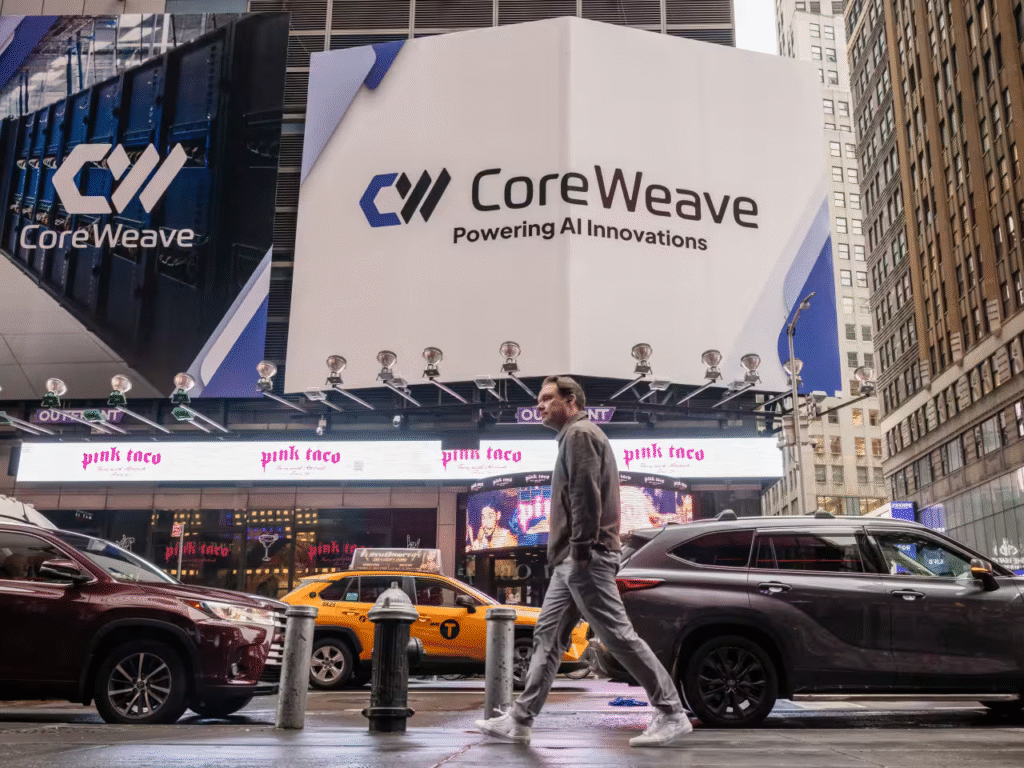1. Company Overview
CoreWeave, branded as “the AI Hyperscaler™,” delivers cutting-edge AI cloud infrastructure tailored to support AI developers and enterprises. Founded in 2017 and headquartered in Livingston, New Jersey, it operates GPU-accelerated data centers across the U.S. and Europe. Since pivoting from cryptocurrency mining to GPU cloud services, CoreWeave has experienced explosive revenue growth—surging 700% in 2024 to reach approximately $1.9 billion, though still posting a net loss of about $863 million. Its infrastructure is built around Nvidia GPUs, offering scalable compute for model training, inference, rendering, and more. Key clients include major names like Microsoft and OpenAI.

2. Most Recent Earnings (Q2 2025)
In Q2 2025, CoreWeave reported $1.21 billion in revenue, growing over 200% year‑over‑year and beating analyst estimates of $1.08 billion. EPS was a loss of –$0.60, missing expectations of approximately –$0.23. Despite top-line strength, net loss reached $290.5 million, driven by soaring operating expenses (~$1.19 billion). On the positive side, adjusted EBITDA reached $753 million, with a 62% margin, and adjusted operating income was $199.8 million (16% margin). Full‑year revenue guidance was raised to $5.15–$5.35 billion.
3. Founding, Funding, Products, Competitors, Headquarters
Founding & Founders: Founded in 2017 (originally as Atlantic Crypto) by Michael Intrator, Brian Venturo, Brannin McBee, and Peter Salanki in New Jersey.
Funding Milestones: Nvidia invested ~$100 million in 2023; in August 2023, CoreWeave secured $2.3 billion in debt financing. By late 2024, valuation climbed to $7 billion following a minority investment led by Fidelity.
Products & Services: Offers GPU compute (e.g., Nvidia H100, H200, GB200 platforms), CPU compute, storage, networking, managed Kubernetes, and developer tools (e.g., Tensorizer, Fleet LifeCycle Controller). Partners with Weights & Biases via acquisition.
Headquarters: Based in Livingston, New Jersey, with data center presence across U.S. and Europe.
Key Competitors: Other cloud compute providers such as AWS, Google Cloud, Microsoft Azure, and specialized AI infrastructure players like Lambda, CoreScientific, and Internal AI chips development by Big Tech.
4. Market & Growth Outlook
CoreWeave operates in the AI infrastructure and GPU cloud computing market, a space experiencing explosive demand. With growth in generative AI and model training, global GPU cloud infrastructure markets are expected to expand at high single- to double-digit CAGRs through 2030. CoreWeave’s aggressive scaling positions it well—but requires massive capex and energy resources. Market growth is fueled by enterprises scaling AI at unprecedented rates.
5. Competitors (1–2 paragraphs)
CoreWeave competes directly with hyperscalers like AWS, Azure, and GCP—all of which offer GPU-accelerated cloud services. However, CoreWeave differentiates via specialized AI focus, custom platform tools, and deeper Nvidia GPU access. Smaller providers like Lambda also compete on dedicated GPU infrastructure but lack the scale. CoreScientific, which CoreWeave plans to acquire, is both a competitor and partner in providing GPU-heavy infrastructure.
6. Unique Differentiation
CoreWeave’s advantages stem from its vertically integrated, AI‑optimized platform: purpose-built for AI workloads, proprietary management tools, prioritization from Nvidia for GPU supply, and fast execution. Its narrow focus allows for greater efficiency and performance compared to general-purpose cloud players.
7. Management Team (up to 3 members)
- Michael Intrator – Co‑founder and CEO
- Brian Venturo – Co‑founder and Chief Strategy Officer
- Brannin McBee – Co‑founder and Chief Development OfficerPeter Salanki serves as CTO; notable hires include Nitin Agrawal (CFO), Chetan Kapoor (Chief Product Officer), and Sachin Jain (COO).
8. Financial Performance (Last 5 Years)
Since pivoting in 2019, CoreWeave has delivered rapid revenue growth—reaching nearly $1.9 billion in 2024, up more than 700% year‑over‑year, reflecting an exceptional CAGR. While top-line performance is impressive, net income remains deeply negative due to aggressive expansion and capex. For Q2 2025 alone, quarterly revenue exceeded $1.2 billion, but net loss still topped $290 million. The balance sheet shows high leverage: significant debt raised for growth, large capex ($2.9 billion in Q2), and high operating costs, though adjusted EBITDA margins remain healthy (~62%). Liquidity and profitability remain risks amid continued investments.
9. Bull Case
- Leadership in GPU‑optimized AI infrastructure, with deep Nvidia partnership and high performance.
- Explosive revenue growth and strong demand tailwinds from AI adoption.
- Strategic acquisitions (Weights & Biases, Core Scientific) enhance vertical integration and capacity.
10. Bear Case
- Aggressive capital burn and heavy debt create financial risk and strain profitability.
- Customer concentration (e.g., Microsoft) elevates revenue dependency risk.
- Operational bottlenecks—energy, infrastructure, and lock-up expirations—may challenge expansion.
11. Analyst Reactions to Earnings
- H.C. Wainwright maintained a Neutral rating despite the AI demand surge and strong results.
- Analysts highlighted concerns over widening losses and infrastructure spending. Melius Research maintained a Hold rating, even after modestly raising price target to ~$128.

The stock is too recent an IPO for the long term chart, but the move lower to $134 post earnings means the key pivot points are $125 and $101, which it could get to, for a reversal. We will wait for those levels to understand if the valuations still make sense.